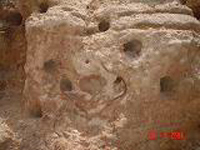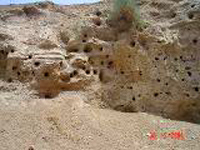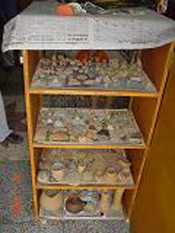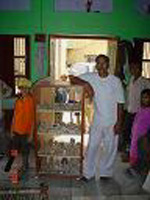| Heritage
|
|||||
The sun was a ball of fire scorching the unclouded skies; the wind was a torrent of dust among the few trees; the road was a ribbon of sunlight upon the grey earth.... and the madmen came riding, came riding in an old Santro.
It was the kind of weather and time - high noon in Haryana's summer - to find only mad dogs and Englishmen out in the sun. Well, we weren't in the sun; not yet. We were in the car, trying to find a village - Rakhigarhi - somewhere near Hissar. We were journeying without maps to a place that would be difficult to find even if we had maps, even if there were maps. We had read - mainly on the web - that in Rakhigarhi, excavations done by the archaeological society had unearthed a site dating back to the Harappan civilization. What had been discovered ? Pottery, walls, houses, streets, canals - a full city that could even be 260 acres - almost as big as Harappa and Mohen-jo-daro! |
Haryana • Overview • Chandigarh
Travelogues
Faces Of India | ||||
Armed with such bravado - and little else - we had set out at 6 in the morning. On the highway to Hissar, asking for directions to Rakhigarhi, to the excavations, to historical Harappan sites, we got quite a few - in completely different directions! Finally, a traffic help station came to our rescue. Straight on towards Hissar, a right to Jind, and then on to Narnaud, and finally a left to Rakhi. Thankfully, the road was reasonably good, and did not peter out to a dirt track until we reached he village.
We asked some excited village kids where the diggings were; just outside the village, at the end of the mud road, they said. But it hadn't been dug in years, they added. Surely, the site must exist; there, aren't those the mounds; I think I can spot something, we said with undying optimism.
Almost on cue, a boy appeared. We struggled with his Haryanvi, but we understood the key facts. The diggings had been here, three years they had dug, three successive winters. Then, they had closed it all and gone away; that was three years ago. Yes, they had found some stuff : pots, canals, houses. He waved at the mound: there, he said, there was a canal, but it was all covered, all gone. The black plastic indicated the sites which were covered up. Nothing else.
Was this it? Was there something? A board marking the site? Someone in the village who was part of the digging? Someone who knew more? We knew we were clutching at straws, but what else was left?
Yes, the boy said suddenly. There is someone who knew more; he could take us to him. And that is how we met Wazir Chand Saroae and his collection of Harappan artifacts. "Friends of Archaeology", his card read. His face was familiar to us from the web; we had spotted him in one of the few snaps of Rakhi on the web. And he told us the tale of a forgotten civilization.
It was a huge site, estimated to be about 260 acres, as big as Harappa and Mohen-jo-daro. Only a third was still available for excavation. The rest was under the village and in the farmlands around the village. And even the one-third left was being swallowed up by the steady expansion of the village. How can I fight this alone, he said. Why doesn't the government do anything? If this were in another country, it might have been so much. Look at Pakistan and how they have maintained Harappa, Mohen-jo-daro. Perhaps, if we researched this, we might have learned in our school books of the Rakhigarhi civilization. Perhaps...
It was as if we had the National Museum at our disposal. A hundred five-thousand-year-old artifacts to play with. A child's toy, a part of a wheel, a set of beads, a little stone - in his hands, each had a story to tell. A story five thousand years old. That's what Wazir Chand Saroae told us, as he held each piece with paternal care.
"Here is where the string went in this toy, and this is how the head of the toy ox bobbed, once upon a time."A hundred little objects, a hundred little stories. "Look at the glaze of this piece. Clearly, a herbal polish that has survived the ravages of time."Each taking you back in time. "This stone is found in Misr( Egpyt), not in India, suggesting a trade link."
"Old pottery is different from new pottery. These shards of pottery are new; see the baking, the glaze, the lightness. Old pottery would be baked harder, and there is always a different sound when it hits the earth. This one now, throw it, hear the sound.. that's new. Here, this piece.. throw it.. this maybe Harappan."
"What! this piece is that old !" We looked incredulously at each other.
"Maybe," he said. "You see those lines of black plastic. This is where the walls were dug up; it's just a few feet deep. A house here. See the four walls? This was a raised dais... perhaps for killing animals. This is the drainage, perhaps to drain the blood. Yes, we found some graveyards too. The rich there; the common man, there. The bodies left like this, with vessels near their hands, not at their feet. A table too for the dead to eat at. This wall, this was a community's wall, and the houses used this as a common wall. Today, a hundred pigeons inhabit the wall. See the oven there ? This was probably the kitchen of the house."
A hundred little objects, a hundred little stories. Each taking you back in time. And a thousand untold stories, lying in the dust beneath our feet. Dying every day while we look the other way.
"Sometime, foreigners come." People from Delhi? "Oh, rarely! Some journalists came, they had these huge cameras, they took pictures and they went away. They said they would write a big article. That was some time ago. "
Wazir Chand Saroae says, "Hopefully, some day, the digs will make a great place out of this village. Tourists will come, this place will grow. Someday..."
|
|||||
Editor: Romola Butalia (c) India Travelogue. All rights reserved. |
|||||
 For us fans of Hampi, this was the stuff of dreams. History beckoned to us : not a thousand years, but five thousand years. Our imagination knew no bounds; every morning, my friend Rohit would wake up with yet another dream of Rakhigarhi. Weekend after weekend, work and work-related travel intervened; this time, we would not be denied. Nothing could stop us this weekend: not the intensity of Haryana's heat in mid-May, not the absence of maps, not the presence of a 9-year-old wondering what these adults were up to.
For us fans of Hampi, this was the stuff of dreams. History beckoned to us : not a thousand years, but five thousand years. Our imagination knew no bounds; every morning, my friend Rohit would wake up with yet another dream of Rakhigarhi. Weekend after weekend, work and work-related travel intervened; this time, we would not be denied. Nothing could stop us this weekend: not the intensity of Haryana's heat in mid-May, not the absence of maps, not the presence of a 9-year-old wondering what these adults were up to.

 We reached the end of the village. A huge mound. A small pond. A couple of cattle in the shelter of the two trees. Three kids from the village. Yes, the diggings used to be here, they said, pointing to the mound. In the blazing heat, we got out of the car and walked on the mound. We reached the highest point from where we could survey all the nearby land. Nothing. Heaps of cow-dung, shards of shattered pottery, a few animal bones, streaks of black plastic. Our last reservoirs of hope and optimism were quickly drying up in the merciless sun.
We reached the end of the village. A huge mound. A small pond. A couple of cattle in the shelter of the two trees. Three kids from the village. Yes, the diggings used to be here, they said, pointing to the mound. In the blazing heat, we got out of the car and walked on the mound. We reached the highest point from where we could survey all the nearby land. Nothing. Heaps of cow-dung, shards of shattered pottery, a few animal bones, streaks of black plastic. Our last reservoirs of hope and optimism were quickly drying up in the merciless sun.
 For three successive winters the ASI had excavated the mound. Wazir Chand Saroae had been part of that team. They had found evidence of a Harappan-era civilization: pottery, toys, kitchen utensils, faming implements, walls, rooms, houses, a canal, a raised platform. But the ASI had gone away closing up the digs with huge sheets of black plastic. An enquiry was being conducted by the CBI regarding the misappropriation of funds. For the last three years, the CBI enquiry had been going on; there was no end in sight.
For three successive winters the ASI had excavated the mound. Wazir Chand Saroae had been part of that team. They had found evidence of a Harappan-era civilization: pottery, toys, kitchen utensils, faming implements, walls, rooms, houses, a canal, a raised platform. But the ASI had gone away closing up the digs with huge sheets of black plastic. An enquiry was being conducted by the CBI regarding the misappropriation of funds. For the last three years, the CBI enquiry had been going on; there was no end in sight.
 He showed us his collection. A wooden case with four shelves. A hundred objects. Each deserving a place in the National Museum. In fact, if you go there, you will see many similar objects, and a lot of displays of Rakhigarhi.
He showed us his collection. A wooden case with four shelves. A hundred objects. Each deserving a place in the National Museum. In fact, if you go there, you will see many similar objects, and a lot of displays of Rakhigarhi.
 "These are just the things the village kids find," he said. "And they give it to me to add to the collection. We have given away most of the things to the museums. There is so much more in the mounds. You can find it yourself; I will show you." We walked out onto the mound, the sun exploding in the barren skies, my head reeling from the haze of heat.
"These are just the things the village kids find," he said. "And they give it to me to add to the collection. We have given away most of the things to the museums. There is so much more in the mounds. You can find it yourself; I will show you." We walked out onto the mound, the sun exploding in the barren skies, my head reeling from the haze of heat.